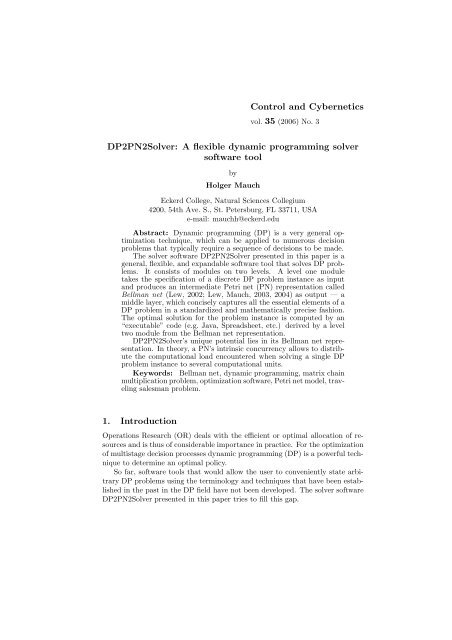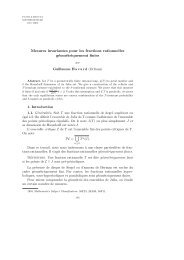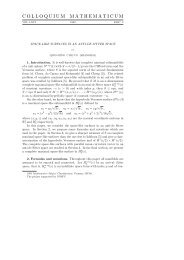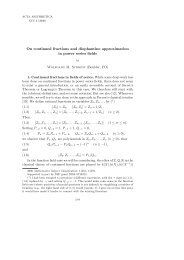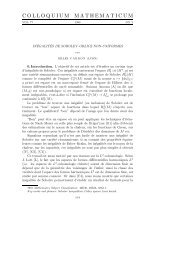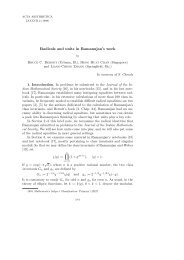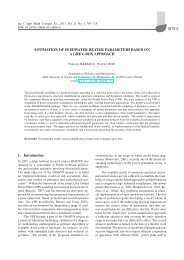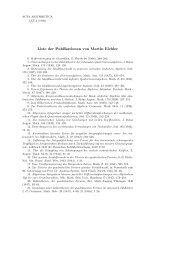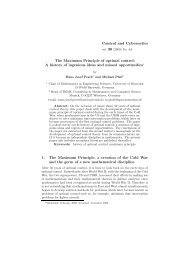DP2PN2Solver: A flexible dynamic programming solver software tool
DP2PN2Solver: A flexible dynamic programming solver software tool
DP2PN2Solver: A flexible dynamic programming solver software tool
You also want an ePaper? Increase the reach of your titles
YUMPU automatically turns print PDFs into web optimized ePapers that Google loves.
Control and Cybernetics<br />
vol. 35 (2006) No. 3<br />
<strong>DP2PN2Solver</strong>: A <strong>flexible</strong> <strong>dynamic</strong> <strong>programming</strong> <strong>solver</strong><br />
<strong>software</strong> <strong>tool</strong><br />
by<br />
Holger Mauch<br />
Eckerd College, Natural Sciences Collegium<br />
4200, 54th Ave. S., St. Petersburg, FL 33711, USA<br />
e-mail: mauchh@eckerd.edu<br />
Abstract: Dynamic <strong>programming</strong> (DP) is a very general optimization<br />
technique, which can be applied to numerous decision<br />
problems that typically require a sequence of decisions to be made.<br />
The <strong>solver</strong> <strong>software</strong> <strong>DP2PN2Solver</strong> presented in this paper is a<br />
general, <strong>flexible</strong>, and expandable <strong>software</strong> <strong>tool</strong> that solves DP problems.<br />
It consists of modules on two levels. A level one module<br />
takes the specification of a discrete DP problem instance as input<br />
and produces an intermediate Petri net (PN) representation called<br />
Bellman net (Lew, 2002; Lew, Mauch, 2003, 2004) as output — a<br />
middle layer, which concisely captures all the essential elements of a<br />
DP problem in a standardized and mathematically precise fashion.<br />
The optimal solution for the problem instance is computed by an<br />
“executable” code (e.g. Java, Spreadsheet, etc.) derived by a level<br />
two module from the Bellman net representation.<br />
<strong>DP2PN2Solver</strong>’s unique potential lies in its Bellman net representation.<br />
In theory, a PN’s intrinsic concurrency allows to distribute<br />
the computational load encountered when solving a single DP<br />
problem instance to several computational units.<br />
Keywords: Bellman net, <strong>dynamic</strong> <strong>programming</strong>, matrix chain<br />
multiplication problem, optimization <strong>software</strong>, Petri net model, traveling<br />
salesman problem.<br />
1. Introduction<br />
Operations Research (OR) deals with the efficient or optimal allocation of resources<br />
and is thus of considerable importance in practice. For the optimization<br />
of multistage decision processes <strong>dynamic</strong> <strong>programming</strong> (DP) is a powerful technique<br />
to determine an optimal policy.<br />
So far, <strong>software</strong> <strong>tool</strong>s that would allow the user to conveniently state arbitrary<br />
DP problems using the terminology and techniques that have been established<br />
in the past in the DP field have not been developed. The <strong>solver</strong> <strong>software</strong><br />
<strong>DP2PN2Solver</strong> presented in this paper tries to fill this gap.
688 H. MAUCH<br />
One of the difficulties in designing a DP <strong>solver</strong> system is to come up with<br />
a specification language that is on the one hand general enough to capture the<br />
majority of DP problems arising in reality, and that is on the other hand structured<br />
enough to be parsed efficiently. For linear <strong>programming</strong> (LP) problems,<br />
it is very easy to achieve both of these goals. For DP problems, however, it is<br />
much harder to satisfy these conflicting goals. An intermediate problem representation<br />
in the form of a Petri net (PN) model turns out to be a useful device<br />
for this purpose. The model used is only applicable to “discrete” optimization<br />
problems for which a DP functional equation with a finite number of states<br />
and decisions can be obtained. Therefore, continuous DP problems cannot be<br />
solved with <strong>DP2PN2Solver</strong>. The term “optimal solution” is used in this paper<br />
not only for the optimal objective function value but also for the sequence of<br />
optimal decisions leading to it.<br />
The computational requirements of <strong>DP2PN2Solver</strong> are asymptotically the<br />
same as the requirements for other DP codes implementing the DP functional<br />
equation directly, since the intermediate PN model may be regarded as just<br />
another representation of a DP functional equation. So for example, since a DP<br />
solution of the traveling-salesman problem is inefficient (exponential-time), so<br />
is a PN modeled solution.<br />
The value of the <strong>DP2PN2Solver</strong> system becomes apparent when we survey<br />
currently existing <strong>software</strong> supporting the solution of DP problems in Section 2.<br />
There seems to be no system that can apply DP to a wide variety of problems.<br />
Current <strong>software</strong> systems can only solve a narrow class of DP problems with a<br />
rather simple DP functional equation.<br />
<strong>DP2PN2Solver</strong> is illustrated by two typical DP problems. The interesting<br />
feature of the first example problem, matrix chain multiplication (MCM), is that<br />
there is not only one, but two successor states in its DP functional equation that<br />
have to be evaluated. The second problem is the traveling salesman problem<br />
(TSP), whose DP functional equation requires the use of set theoretic operators.<br />
It will be demonstrated that <strong>DP2PN2Solver</strong> has no problems in dealing<br />
with these problems which are slightly more complicated than finding, say, the<br />
shortest path in a multistage graph (the standard textbook example for DP).<br />
The organization of the paper is to start with a brief survey of existing<br />
DP <strong>solver</strong> systems (Section 2), then to give the general architecture of our<br />
<strong>DP2PN2Solver</strong> <strong>software</strong> (Section 3), followed by a more detailed description of<br />
<strong>DP2PN2Solver</strong>’s modules (Sections 4 – 6) and to end with a short conclusion<br />
section.<br />
2. Other DP <strong>software</strong> systems<br />
We briefly survey existing <strong>software</strong> systems that support the user in solving<br />
instances of DP problems.<br />
Attempts to develop general-purpose DP computer codes have been made in<br />
the early 70’s by Hastings (1974) and others. While Hasting’s “DYNACODE”
Dynamic Programming with Petri net <strong>solver</strong> 689<br />
is frequently referenced (e.g. in Hastings, 1973), detailed information about<br />
this system is unavailable as of today. Sniedovich characterizes these codes as<br />
problem specific and concludes that “no general-purpose <strong>dynamic</strong> <strong>programming</strong><br />
computer codes seem to be available commercially” (Sniedovich, 1992, p. 193).<br />
Other, non-general DP codes have been developed in Hubert, Arabie, Meulman<br />
(2001), Lin and Bricker (1990), Sniedovich (1993, 1994). DP <strong>software</strong><br />
accompanying textbooks such as Hillier and Lieberman (1990) does not generalize<br />
well either. The shortcoming of these attempts is that they are usually<br />
restricted to solve instances of one special problem.<br />
Mailund’s DPROG system atwww.daimi.au.dk/~mailund assumes that the<br />
user has a substantial amount of expertise in <strong>software</strong> engineering practice. As<br />
of today it seems that major parts of the system are still under construction.<br />
The optimization package system LINGO / LINDO solves optimization<br />
problems across a wide problem domain with a variety of solution methods.<br />
While its strength lies in the areas of linear <strong>programming</strong>, and to some extent<br />
in integer <strong>programming</strong> and nonlinear <strong>programming</strong>, it is only of very limited<br />
use to tackle DP problems. In particular, it is not obvious at all how to retrieve<br />
the series of optimal decisions that lead to the optimal solution.<br />
A disadvantage of this and many other optimization <strong>software</strong> systems is that<br />
they incorporate search mechanisms. This can in the best case be very efficient,<br />
but in the worst case not lead to the optimal solution at all.<br />
The most common approach taken today for solving real-world DP problems<br />
is to start a specialized <strong>software</strong> development project for each and every problem.<br />
Even taking into account that a module-oriented development philosophy allows<br />
considerable reuse of components, this is still a rather expensive approach. A<br />
general <strong>solver</strong> solution like the <strong>DP2PN2Solver</strong> introduced here should be able<br />
to save <strong>software</strong> development costs for many DP problems arising in practice.<br />
3. <strong>DP2PN2Solver</strong> architecture<br />
Fig. 1 gives an overview of the architecture of the <strong>DP2PN2Solver</strong> <strong>software</strong> <strong>tool</strong><br />
(in the form of a Petri net). The static components such as input files, intermediate<br />
representations and output files are depicted as places. The <strong>dynamic</strong><br />
components such as compiler and code generator are shown as transitions. Solid<br />
arcs connect fully working components while dotted arcs connect components<br />
that are under construction and that should be available in future versions of<br />
<strong>DP2PN2Solver</strong>.<br />
<strong>DP2PN2Solver</strong> consists of modules on two levels. Level one modules<br />
(gDP2PN, bDP2PN, etc.) take the specification of a discrete DP problem instance<br />
as input and produce an intermediate Petri net (PN) representation<br />
called Bellman net (Lew, 2002; Lew and Mauch, 2003, 2004) as output – a<br />
middle layer, which concisely captures all the essential elements of a DP problem<br />
in a standardized and mathematically precise fashion. Level two modules<br />
(PN2Java, PN2XML, PN2Spreadsheet, etc.) take the intermediate Bellman net
690 H. MAUCH<br />
DP specification<br />
source file types<br />
gDPS source<br />
(.dp suffix)<br />
bDPS source<br />
AMPL source<br />
gDP2PN<br />
compiler<br />
bDP2PN<br />
compiler<br />
... ...<br />
internal<br />
Bellman net<br />
representation<br />
PN2Java module<br />
PN2XML module<br />
...<br />
PN2Spreadsheet<br />
"Executable codes"<br />
Java <strong>solver</strong><br />
code<br />
PNML standard<br />
file<br />
Spreadsheet<br />
file<br />
Figure 1. Architecture of the <strong>DP2PN2Solver</strong> Tool<br />
JRE<br />
PN simulator<br />
Spreadsheet<br />
application<br />
Solution of<br />
DP Instance<br />
Solution of<br />
DP Instance<br />
Solution of<br />
DP Instance<br />
representation as input and produce an “executable” <strong>solver</strong> code as output; that<br />
is any kind of code from which the solution can be obtained in the next step.<br />
E.g. a Java system could compile and interprete a Java source, a spreadsheet<br />
application could open a spreadsheet file and calculate all cells, or a PN system<br />
could simulate a PN provided in a standard XML-based PN file interchange<br />
format.<br />
To summarize, the following are the steps that need to be performed to<br />
solve a DP problem instance; only step 1 is performed by the human DP modeler<br />
whereas all other steps are automatically performed by the <strong>DP2PN2Solver</strong><br />
system.<br />
1. Model the real-world problem and create the DP specification file, for<br />
example in the gDPS language (see Section 4).<br />
2. The appropriate DP2PN module produces the intermediate Bellman net<br />
representation (see Section 5).<br />
3. One of the PN2Solver modules produces runnable Java code, or a spreadsheet<br />
or another form of executable <strong>solver</strong> code, which is capable of solving<br />
the problem instance.<br />
4. Run the resulting executable <strong>solver</strong> code and output the solution of the<br />
problem instance (see Section 6).<br />
4. The DP specification language<br />
DP problems can can take on various forms and shapes. This is why it is hard to<br />
specify a strict and fixed specification format like for linear <strong>programming</strong> (LP).<br />
But there are common themes across all DP problems and those are captured<br />
in the general DP specification (gDPS) language.<br />
A special purpose language should allow for both a convenient description
Dynamic Programming with Petri net <strong>solver</strong> 691<br />
of a DP problem instance and efficient parsing of the specification. The gDPS<br />
language has been designed as a general source language that can describe a<br />
variety of DP problems. It offers the flexibility needed for the various types of<br />
DP problems that arise in reality. Sources in gDPS for the matrix chain multiplication<br />
and for the traveling salesman problem are given in Subsections 4.1<br />
and 4.2, respectively. Other DP problems that have been successfully modelled<br />
with gDPS and solved by <strong>DP2PN2Solver</strong> include the shortest path problem<br />
(cyclic graphs allowed), reliability design problems (with multiplication operator<br />
in DP functional equation), the longest common subsequence problem, the<br />
optimal edit distance problem, the optimal binary search tree problem, and<br />
many more.<br />
A gDPS consists of several structured sections, which reflect the standard<br />
parts of every DP problem. To increase writability, additional information such<br />
as helper functions that ease the DP model formulation can be included into a<br />
gDPS source. Of particular importance are the following sections.<br />
• The optionalGENERAL_VARIABLES section allows the definition of variables<br />
(e.g. of type int, double, or String) in a C++/Java style syntax.<br />
• The optional SET_VARIABLES section allows the definition of variables of<br />
type Set (which can take on a set of integers as value) in a convenient<br />
enumerative fashion the way it is written in mathematics. Ellipsis is supported<br />
with a subrange syntax.<br />
• The optionalGENERAL_FUNCTIONSsection allows the definition of arbitrary<br />
functions in a C++/Java style syntax.<br />
• The mandatory STATE_TYPE section. A state in a DP problem can be<br />
viewed as an ordered tuple of variables. The variables can be of heterogeneous<br />
types. The “stage” of a DP problem would, as an integer coordinate<br />
of its state, be one part of the ordered tuple.<br />
• The mandatory DECISION_VARIABLE and DECISION_SPACE sections declare<br />
the type of a decision and the set of decisions from which to choose<br />
(the space of alternatives), which is given as a function of the state.<br />
• The mandatory DP functional equation (DPFE). The recursive equation<br />
is described in the DPFE section and its base cases must either be expressed<br />
in conditional fashion in the DPFE_BASE_CONDITIONS or in a enumerative<br />
way in the DPFE_BASE section.<br />
• The computational goal of the DP instance is given in the mandatoryGOAL<br />
section.<br />
• The reward function (cost function) is given as a function of the state and<br />
the decision in the mandatory REWARD_FUNCTION section.<br />
• The transformation functions (one or more) are given as functions of the<br />
state and the decision in the mandatory TRANSFORMATION_FUNCTION section.<br />
Set theoretic features in the gDPS language simplify the specification and<br />
improve its readability. A variable of the type Set can be declared in the
692 H. MAUCH<br />
SET_VARIABLES section. Such variables and set literals (described using complete<br />
enumeration, or a subrange syntax) can be operands of set theoretic operations<br />
like SETUNION, SETINTERSECTION or SETMINUS.<br />
Throughout a gDPS source it is legal to document it using C++/Java style<br />
block comments (between /* and */) and line comments (starting with //).<br />
Since the GENERAL_VARIABLES section allows the definition of arbitrary variables<br />
and the GENERAL_FUNCTIONS section allows the definition of arbitrary<br />
(computable) functions in a C++/Java style syntax, the gDPS language is powerful<br />
and <strong>flexible</strong>. Despite this power and flexibility, the other sections require<br />
a very structured format, which makes a gDPS very readable and produces a<br />
specification that resembles the mathematical formulation closely. The hybrid<br />
approach of <strong>flexible</strong> C++/Java style elements and strictly structured sections<br />
makes it easy to learn the gDPS language.<br />
Input data that is specific to a DP instance is hardwired into the gDPS<br />
source in order to have a single gDPS source file that contains the complete<br />
specification of the DP instance. If it seems more desirable to keep separate<br />
files for the instance specific data and the problem specific data, this would<br />
require a conceptually straightforward modification which we will not elaborate<br />
on any further here.<br />
<strong>DP2PN2Solver</strong>’s architecture is expandable and open to alternative source<br />
DP specification languages (see figure 1). For example, if the user desires to<br />
solve only very basic DP problems that involve only integer types as states or<br />
decisions, so that declarations are not necessary, then a much simpler language,<br />
the basic DP specification (bDPS) language, is sufficient. By adding a compiler<br />
to <strong>DP2PN2Solver</strong> that translates the bDPS into the Bellman net representation<br />
it becomes possible to use the other parts of the <strong>DP2PN2Solver</strong> system without<br />
any further changes. Even compilers for established mathematical <strong>programming</strong><br />
languages like AMPL, GAMS, OPL, or other languages mentioned in section 2<br />
can be envisioned. Those could easily be integrated into <strong>DP2PN2Solver</strong> (even<br />
though the development of the compiler itself might require a substantial initial<br />
implementation effort), so that users can write the DP specification in their<br />
favorite language.<br />
4.1. The matrix chain multiplication (MCM) problem example<br />
Given a product A1A2 · · · An of matrices of various (but still compatible) dimensions,<br />
the goal is to find a parenthesization, which minimizes the number of<br />
componentwise multiplications. The dimensions of Ai are denoted by di−1 and<br />
di. The DP functional equation can be expressed as<br />
�<br />
min<br />
f(i, j) = k∈{i,...,j−1} {f(i, k) + f(k + 1, j) + di−1dkdj} if i < j<br />
0 if i = j.<br />
The total number of componentwise multiplications is computed as f(1, n).<br />
(1)
Dynamic Programming with Petri net <strong>solver</strong> 693<br />
For instance, let n = 4 and (d0, d1, d2, d3, d4) = (3, 4, 5, 2, 2). Apply the DP<br />
functional equation (1) in a bottom up fashion to compute f(1, 4) = 76. By<br />
keeping track of which arguments minimize the min-expressions in each case,<br />
one arrives at the optimal parenthesization ((A1(A2A3))A4).<br />
This DP problem instance can be coded in gDPS as follows:<br />
BEGIN<br />
NAME MCM; //Matrix Chain Multiplication<br />
END<br />
GENERAL_VARIABLES_BEGIN<br />
//dimensions in Matrix Chain Multiplication problem<br />
private static int[] dimension = {3, 4, 5, 2, 2};<br />
private static int n = dimension.length-1; //n=4 matrices<br />
GENERAL_VARIABLES_END<br />
STATE_TYPE: (int firstIndex, int secondIndex);<br />
DECISION_VARIABLE: int k;<br />
DECISION_SPACE: decisionSet(firstIndex,secondIndex)<br />
={firstIndex,..,secondIndex - 1};<br />
GOAL: f(1,n);<br />
DPFE_BASE_CONDITIONS:<br />
f(firstIndex,secondIndex)=0.0 WHEN (firstIndex==secondIndex);<br />
DPFE: f(firstIndex,secondIndex)<br />
=MIN_{k IN decisionSet}<br />
{ f(t1(firstIndex,secondIndex,k))<br />
+f(t2(firstIndex,secondIndex,k))<br />
+r(firstIndex,secondIndex,k)<br />
};<br />
REWARD_FUNCTION: r(firstIndex,secondIndex,k)<br />
=dimension[firstIndex - 1]<br />
*dimension[k]*dimension[secondIndex];<br />
TRANSFORMATION_FUNCTION: t1(firstIndex,secondIndex,k)<br />
=(firstIndex,k);<br />
t2(firstIndex,secondIndex,k)<br />
=(k+1,secondIndex);
694 H. MAUCH<br />
4.2. The traveling salesman problem (TSP) example<br />
Given a complete weighted directed graph G = (V, E) with distance matrix<br />
C = (ci,j) the optimization version of the traveling saleman problem asks to<br />
find a minimal Hamiltonian cycle (visiting each of the n = |V | vertices exactly<br />
once). Without loss of generality assume V = {0, . . ., n−1}. The DP functional<br />
equation can be expressed as<br />
f(v, S) =<br />
� min<br />
d/∈S {f(d, S ∪ {d}) + cv,d} if |S| < n<br />
cv,s<br />
if |S| = n<br />
where the length of the minimal cycle is computed as f(s, {s}), with s ∈ V .<br />
(The choice of the starting vertex s is irrelevant, since we are looking for a<br />
cycle, so arbitrarily pick s = 0.) In the above DP functional equation (2), a<br />
state is a pair (v, S) where v can be interpreted as the current vertex and S as<br />
the set of vertices already visited.<br />
For instance, let<br />
⎛<br />
⎜<br />
C = ⎜<br />
⎝<br />
0 1 8 9 60<br />
2 0 12 3 50<br />
7 11 0 6 14<br />
10 4 5 0 15<br />
61 51 13 16 0<br />
⎞<br />
⎟<br />
⎠ .<br />
Apply the DP functional equation (2) to compute f(0, {0}) = 39. By keeping<br />
track of which arguments minimize the min-expressions in each case, we find<br />
that the minimal cycle is (0, 1, 3, 4, 2).<br />
Note the convenient use of variables and literals of the type Set in the<br />
following gDPS example for this problem instance.<br />
BEGIN<br />
NAME TSP; //TravelingSalesmanProblem;<br />
GENERAL_VARIABLES_BEGIN<br />
//adjacency matrix for TSP.<br />
private static int[][] distance =<br />
{<br />
{ 0, 1, 8, 9, 60},<br />
{ 2, 0, 12, 3, 50},<br />
{ 7, 11, 0, 6, 14},<br />
{10, 4, 5, 0, 15},<br />
{61, 51, 13, 16, 0}<br />
};<br />
private static int n = distance.length;<br />
//number of nodes n=5. Nodes are named starting<br />
//at index 0 through n-1.<br />
(2)
Dynamic Programming with Petri net <strong>solver</strong> 695<br />
END<br />
GENERAL_VARIABLES_END<br />
SET_VARIABLES_BEGIN<br />
Set setOfAllNodes={0,..,n - 1};<br />
Set goalSet={0};<br />
SET_VARIABLES_END<br />
STATE_TYPE: (int currentNode, Set nodesVisited);<br />
DECISION_VARIABLE: int d;<br />
DECISION_SPACE: nodesNotVisited(currentNode,nodesVisited)<br />
=setOfAllNodes SETMINUS nodesVisited;<br />
GOAL:<br />
f(0,goalSet); //that is: (0,{0});<br />
DPFE_BASE_CONDITIONS:<br />
f(currentNode, nodesVisited)<br />
=distance[currentNode][0]<br />
WHEN (nodesVisited SETEQUALS setOfAllNodes);<br />
DPFE: f(currentNode,nodesVisited)<br />
=MIN_{d IN nodesNotVisited}<br />
{ cost(currentNode,nodesVisited,d)<br />
+f(t(currentNode,nodesVisited,d))};<br />
REWARD_FUNCTION: cost(currentNode,nodesVisited,d)<br />
=distance[currentNode][d];<br />
TRANSFORMATION_FUNCTION: t(currentNode,nodesVisited,d)<br />
=(d, nodesVisited SETUNION {d});<br />
5. The intermediate Bellman net representation<br />
Familiarity with basic Petri net terminology is assumed in this paper. Detailed<br />
introductions to PNs are Reisig (1985) and Murata (1989). For colored PNs,<br />
see Jensen (1992).<br />
The details for the Bellman nets used in <strong>DP2PN2Solver</strong> are described in<br />
Lew (2002), Lew and Mauch (2003, 2004). The most important features are<br />
summarized in this section.<br />
A Bellman net is a special high-level colored Petri net with the following<br />
properties.
696 H. MAUCH<br />
1. The color type is numerical in nature, tokens are real numbers. In addition,<br />
single black tokens, depicted [] in Fig. 2, are used to initialize<br />
enabling places, which are technicalities that prevent transitions from firing<br />
more than once.<br />
2. A place contains at most one token at any given time.<br />
3. The postset of a transition contains exactly one designated output place,<br />
which contains the result of the computational operation performed by<br />
the transition. (In the example Bellman nets shown in Figs. 2 and 3<br />
designated output places are labeled p1 throughp16, base state places are<br />
labeled p17 through p20, and enabling places are not labeled.)<br />
4. There are two different types of transitions, namely M-transitions and<br />
E-transitions. An M-transition performs a minimization or maximization<br />
operation using the tokens of the places in its preset as operands and puts<br />
the result into its designated output place. An E-transition evaluates a<br />
basic arithmetic expression (involving operators like addition or multiplication)<br />
using fixed constants and tokens of the places in its preset as<br />
operands and puts the result into its designated output place. (In the<br />
example Bellman nets shown in Figs. 2 and 3 M-transitions are labeled m1<br />
through m6, E-transitions are labeled s1 through s10.)<br />
5. There are self-loops between an E-transition and all places in its preset.<br />
Their purpose is to conserve operands serving as input for more than one<br />
E-transition.<br />
A numerical token as the marking of a place in a Bellman net can be interpreted<br />
as an intermediate value that is computed in the course of calculating<br />
the solution of a corresponding DP problem instance.<br />
For example, the Bellman net of the MCM problem instance, in its initial<br />
marking, is depicted in Fig. 2.<br />
To obtain the final marking of the Bellman net, fire transitions until the net<br />
is dead. The net in its final marking is depicted in Fig. 3. Note that the goal<br />
state place p1 contains f(1, 4) = 76 tokens now, the correct value indeed. Also,<br />
the marking of an intermediate state place represents the optimal value for the<br />
associated subproblem. For example, the value of the intermediate state place<br />
p6 is f(2, 4) = 56 which is the number of componentwise multiplications for the<br />
optimally parenthesized matrix product A2 · · · A4<br />
Note that the order in which transitions fire is not relevant for the value of<br />
the final result f(1, 4).<br />
Note also how the intermediate Bellman net representation gives an illustrative<br />
graphical representation of the problem instance. Also, since there is<br />
an abundance of PN theory that allows to examine certain properties of PNs<br />
like circularity, liveness, etc. there is the chance for extensive automated consistency<br />
checks on the PN level which could unveil certain mistakes made by the<br />
DP modeler when giving the DP specification.
Figure 2. Bellman net in its initial marking for the MCM problem instance<br />
p1<br />
f(1,4)<br />
y<br />
m1<br />
p2<br />
y=Math.<br />
min(x1,Math.<br />
min(x2,x3))<br />
x1<br />
x2<br />
x3<br />
p4<br />
p3<br />
[]<br />
s1<br />
y=x1+x2+24<br />
y<br />
[]<br />
y y=x1+x2+30<br />
y<br />
x2<br />
s2<br />
x1<br />
y=x1+x2+12<br />
[]<br />
s3<br />
f(1,3)<br />
f(2,4)<br />
p5<br />
p6<br />
x1<br />
x1<br />
y<br />
x2<br />
y<br />
x2<br />
m2<br />
y=Math.<br />
min(x1,x2)<br />
m3<br />
y=Math.<br />
min(x1,x2)<br />
x1<br />
x2<br />
x1<br />
p7<br />
p8<br />
x2<br />
p9<br />
p10<br />
y<br />
y<br />
y<br />
[]<br />
s4<br />
y=x1+x2+24<br />
y<br />
s7<br />
x2<br />
[]<br />
s5<br />
x1<br />
y=x1+x2+30<br />
x1<br />
[] s6<br />
x2<br />
y=x1+x2+40<br />
x2<br />
[]<br />
x1<br />
y=x1+x2+16<br />
x1<br />
p11<br />
x<br />
f(1,2)<br />
p12<br />
x<br />
f(2,3)<br />
p13<br />
x<br />
f(3,4)<br />
x2<br />
m4<br />
m5<br />
m6<br />
x<br />
x<br />
x<br />
p14<br />
p15<br />
p16<br />
y<br />
y<br />
y<br />
[]<br />
s8<br />
y=x1+x2+60<br />
[]<br />
s9<br />
y=x1+x2+40<br />
[] s10<br />
y=x1+x2+20<br />
x1<br />
x2<br />
x1<br />
x2<br />
x1<br />
x2<br />
p17<br />
0 f(1,1)<br />
p18<br />
0 f(2,2)<br />
p19<br />
0 f(3,3)<br />
p20<br />
0<br />
f(4,4)<br />
Dynamic Programming with Petri net <strong>solver</strong> 697
Figure 3. Bellman net in its final marking for the MCM problem instance<br />
p1<br />
76<br />
f(1,4)<br />
y<br />
m1<br />
p2<br />
y=Math.<br />
min(x1,Math.<br />
min(x2,x3))<br />
x1<br />
x2<br />
x3<br />
p4<br />
p3<br />
s1<br />
y=x1+x2+24<br />
y<br />
y y=x1+x2+30<br />
y<br />
x2<br />
s2<br />
x1<br />
y=x1+x2+12<br />
s3<br />
p5<br />
x1<br />
f(1,3) 64 y<br />
x1<br />
x2<br />
f(2,4) 56 y<br />
p6<br />
x2<br />
m2<br />
y=Math.<br />
min(x1,x2)<br />
m3<br />
y=Math.<br />
min(x1,x2)<br />
x1<br />
x2<br />
x1<br />
p7<br />
p8<br />
x2<br />
p9<br />
p10<br />
y<br />
y<br />
y<br />
y<br />
s4<br />
y=x1+x2+24<br />
s7<br />
x2<br />
x1<br />
s5<br />
y=x1+x2+30<br />
x1<br />
s6<br />
x2<br />
y=x1+x2+40<br />
x2<br />
x1<br />
y=x1+x2+16<br />
x1<br />
p11<br />
60 x<br />
f(1,2)<br />
p12<br />
40 x<br />
f(2,3)<br />
p13<br />
20 x<br />
f(3,4)<br />
x2<br />
m4<br />
m5<br />
m6<br />
x<br />
x<br />
x<br />
p14<br />
p15<br />
p16<br />
y<br />
y<br />
y<br />
s8<br />
y=x1+x2+60<br />
s9<br />
y=x1+x2+40<br />
s10<br />
y=x1+x2+20<br />
x1<br />
x2<br />
x1<br />
x2<br />
x1<br />
x2<br />
p17<br />
0 f(1,1)<br />
p18<br />
0 f(2,2)<br />
p19<br />
0 f(3,3)<br />
p20<br />
0<br />
f(4,4)<br />
698 H. MAUCH
Dynamic Programming with Petri net <strong>solver</strong> 699<br />
In contrast to the Bellman net model described here, Mauch (2004) describes<br />
a non-colored PN approach that can also be used as an intermediate representation<br />
of DP problem instances. While the expressional power of both approaches<br />
seems to be equivalent (no proof yet) it is easier to transform Bellman nets<br />
to executable computer code. However, the low level PN model introduced in<br />
Mauch (2004) is easier to examine with respect to consistency, and other net<br />
theoretic issues. If the equivalence of the two models can be shown, and a practical<br />
transformation algorithm between the two models can be designed, then<br />
one could take advantage of the benefits of both models.<br />
Current standardization efforts (see Billington et al., 2003) introduce the<br />
Petri Net Markup Language (PNML) as an XML-based interchange format for<br />
PNs. Although the PNML standard still undergoes changes, <strong>DP2PN2Solver</strong><br />
contains a module PN2XML that is capable of producing a standard file format<br />
from a Bellman net. By importing the standard file into a PN simulator like<br />
Renew (Kummer, Wienberg, Duvigneau, 2002) this opens up the possibility to<br />
simulate the Bellman net with external PN systems. Now the user can watch<br />
how a DP problem instance is solved in an illustrative graphical fashion by observing<br />
the simulation progress. The shortcomings of solving DP problems in<br />
this way are performance penalties due to the overhead of the PN simulation<br />
system, and the fact that only the optimal value of the solution is observable,<br />
but not the decisions leading to the optimum. Therefore the following section<br />
discusses the PN2Java module of <strong>DP2PN2Solver</strong> which overcomes these problems.<br />
6. The solution code<br />
The PN2Java module of <strong>DP2PN2Solver</strong> generates Java sources that efficiently<br />
produce the optimal solution to the underlying DP problem instance, along with<br />
the series of optimal decisions leading to it. (Note the use of the term “efficient”<br />
in this context. If the underlying DP problem is inherently inefficient — as in<br />
the TSP example — then PN2Java will produce an inefficient output. The point<br />
made here is that the transformation process itself is efficient.) A Java-based<br />
<strong>solver</strong> code takes advantage of the ubiquitous and free availability of the Java<br />
compile and run-time system. PN2Java also ensures that the produced code is<br />
well commented and human-readable, so it is possible to verify its correctness,<br />
or use the code as a building block for a larger <strong>software</strong> development project.<br />
Executing the bare Java code without any further modifications leads to the<br />
following output for the two examples introduced earlier.<br />
The solution for the MCM problem example:<br />
The optimal value is: 76.0<br />
The solution tree is:<br />
State (1,4) has optimal value: 76.0<br />
Decision k=3
700 H. MAUCH<br />
State (1,3) has optimal value: 64.0<br />
Decision k=1<br />
Base state (1,1) has initial value: 0.0<br />
State (2,3) has optimal value: 40.0<br />
Decision k=2<br />
Base state (2,2) has initial value: 0.0<br />
Base state (3,3) has initial value: 0.0<br />
Base state (4,4) has initial value: 0.0<br />
The solution for the TSP problem example:<br />
The optimal value is: 39.0<br />
The solution tree is:<br />
State (0,{0}) has optimal value: 39.0<br />
Decision d=1<br />
State (1,{0,1}) has optimal value: 38.0<br />
Decision d=3<br />
State (3,{0,1,3}) has optimal value: 35.0<br />
Decision d=4<br />
State (4,{0,1,3,4}) has optimal value: 20.0<br />
Decision d=2<br />
Base state (2,{0,1,2,3,4}) has initial value: 7.0<br />
The TSP is NP-complete, and the time complexity of <strong>DP2PN2Solver</strong> for<br />
TSP is exponential in the number n of vertices in the graph. This is inherent<br />
in the formulation of TSP as a DP problem.<br />
As an alternative to the presented PN2Java module one could envision a<br />
module that transforms the Bellman net directly into machine code (for applications<br />
that require the utmost performance at the expense of machine independence).<br />
Another idea is to translate the Bellman net into a spreadsheet<br />
file. Spreadsheet formats are quite popular in the OR community and in management<br />
science, and a graphically appealing output of the optimal decisions<br />
within a spreadsheet should be a valuable <strong>tool</strong> for decision makers. Such a<br />
module (PN2Spreadsheet) is currently under construction.<br />
7. Conclusion<br />
With <strong>DP2PN2Solver</strong> it becomes possible to automatically solve many optimization<br />
problems of practical relevance with DP. This constitutes a considerable<br />
improvement of today’s use of DP, where usually for each problem at hand specialized<br />
<strong>software</strong> development takes place. The <strong>DP2PN2Solver</strong> user no longer<br />
needs deep skills in <strong>software</strong> development to solve a problem. After gaining insight<br />
into the nature of the real-world problem to be solved, the user can focus<br />
on the important modeling process and come up with a precise DP specification<br />
(in particular the DP functional equation) of the problem. It is no longer
Dynamic Programming with Petri net <strong>solver</strong> 701<br />
necessary to worry about the DP solution process itself, since <strong>DP2PN2Solver</strong><br />
automates all other steps.<br />
<strong>DP2PN2Solver</strong> guarantees that the optimal solution to a DP instance will<br />
be found, provided of course that the DP functional equation is correct and its<br />
solution does exist.<br />
The gDPS language is easy to learn, so <strong>DP2PN2Solver</strong> should also be a<br />
great educational <strong>tool</strong> for teaching DP in a practical hands on approach, where<br />
students can work on case studies, model the underlying DP problem, and get<br />
an actual solution to the problem without the need to worry too much about<br />
the solution process itself.<br />
The structured design of the gDPS language allows for the addition of a<br />
straightforward graphical user input mask as a frontend to make the modeling<br />
of the DP specification even more convenient in future versions.<br />
References<br />
Billington, J., Christensen, S., Hee, K.V., Kindler, E., Kummer, O.,<br />
Petrucci, L., Petrucci, L., Post, R., Stehno, C., and Weber,<br />
M. (2003) The Petri net markup language: Concepts, technology, and<br />
<strong>tool</strong>s. In: W. van der Aalst and E. Best, eds., ICATPN 2003, LNCS,<br />
2679, Springer-Verlag, 483–505.<br />
Hastings, N. (1973) Dynamic <strong>programming</strong> with management applications.<br />
Butterworths, London, England, 1973.<br />
Hastings, N. (1974) DYNACODE <strong>dynamic</strong> <strong>programming</strong> systems handbook.<br />
Management Center, University of Bradford, Bradford, England.<br />
Hillier, F.S. and Lieberman, G.J. (1990) Introduction to operations research,<br />
5th edition. McGraw-Hill Publishing Company. New York.<br />
Hubert, L.J., Arabie, P. and Meulman, J. (2001) Combinatorial data<br />
analysis: Optimization by <strong>dynamic</strong> <strong>programming</strong>. Society for Industrial<br />
and Applied Mathematics (SIAM). Philadelphia, PA.<br />
Jensen, K. (1992) Coloured Petri Nets, Vol. 1. Springer-Verlag.<br />
Kummer, O., Wienberg, F., and Duvigneau, M. (2002) Renew User<br />
Guide Release 1.6. Department of Informatics. University of Hamburg,<br />
Hamburg, Germany.<br />
Lew, A. (2002) A Petri net model for discrete <strong>dynamic</strong> <strong>programming</strong>. In:<br />
Proceedings of the 9th Bellman Continuum: International Workshop on<br />
Uncertain Systems and Soft Computing. Beijing, China, July 24–27, 16–<br />
21.<br />
Lew, A. and Mauch, H. (2003) Solving integer <strong>dynamic</strong> <strong>programming</strong> using<br />
Petri nets. In: Proceedings of the Multiconference on Computational<br />
Engineering in Systems Applications (CESA). July 9–11, Lille, France.<br />
Lew, A. and Mauch, H. (2004) Bellman nets: A Petri net model and <strong>tool</strong> for<br />
<strong>dynamic</strong> <strong>programming</strong>. In: Proceedings of Modelling, Computation and<br />
Optimization in Information Systems and Management Sciences (MCO).
702 H. MAUCH<br />
July 1–3, Metz, France.<br />
Lin, E.Y. and Bricker, D.L. (1990) Implementing the recursive APL code<br />
for <strong>dynamic</strong> <strong>programming</strong>. APL Quote Quad 20 (4), 239–250.<br />
Mauch, H. (2004) A Petri net representation for <strong>dynamic</strong> <strong>programming</strong> problems<br />
in management applications. In: Proceedings of the 37th Hawaii International<br />
Conference on System Sciences (HICSS2004). January 5–8,<br />
Waikoloa, Hawaii. IEEE Computer Society.<br />
Murata, T. (1989) Petri nets: Properties, analysis and applications. Proceedings<br />
of the IEEE 77 (4), 541–580.<br />
Reisig, W. (1985) Petri Nets: an Introduction. Springer-Verlag, Berlin.<br />
Sniedovich, M. (1992) Dynamic <strong>programming</strong>. Marcel Dekker, Inc., New<br />
York.<br />
Sniedovich, M. (1993) A <strong>dynamic</strong> <strong>programming</strong> algorithm for the travelling<br />
salesman problem. ACM SIGAPL APL Quote Quad 23 (4), 1–3.<br />
Sniedovich, M. (1994) Dynamic <strong>programming</strong> algorithms for the knapsack<br />
problem. ACM SIGAPL APL Quote Quad 24 (3), 18–21.


